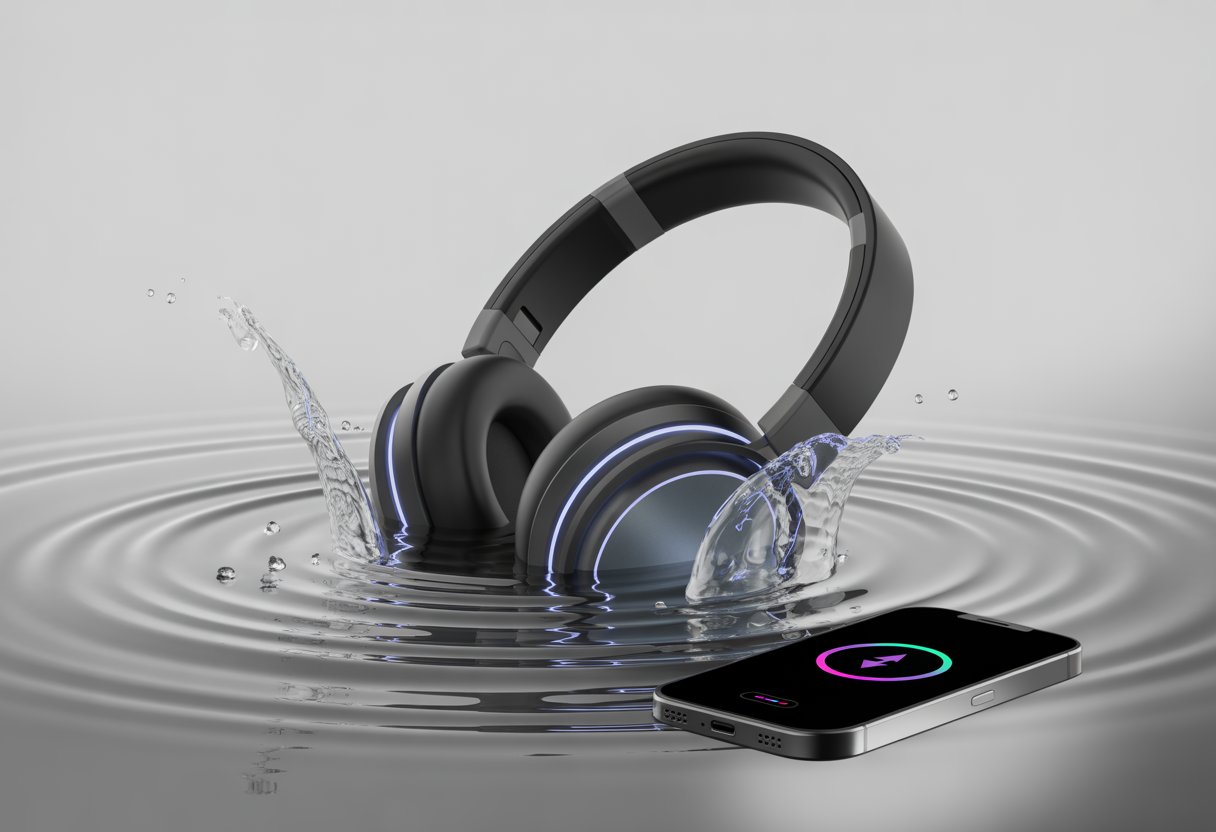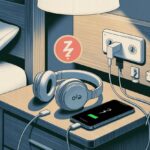We’ve all been there—jamming out to our favorite songs, then suddenly, our Bluetooth headphones or earbuds take an unexpected dive. Maybe a rainstorm hits, or we drop them in the sink. Now they won’t play music, and we’re left scratching our heads. When Bluetooth headphones get wet, water sneaks inside and wrecks those tiny electronic parts that make our music sound so good.

Moisture really is a supervillain for headphones and earbuds. It messes with circuit boards, shorts out batteries, and can ruin speakers in a snap.
No wonder our headphones go silent after a splash. If you’re curious whether they can be saved—or why some work after drying while others don’t—let’s dig into what happens inside those little gadgets and what (if anything) we can try to bring them back to life.
Honestly, nobody wants to toss their favorite headphones just because of a little water. So let’s see how doomed our soggy headphones and earbuds really are, and maybe laugh a little at our own bad luck.
How Water Damages Bluetooth Headphones
When Bluetooth headphones or earbuds get wet, even a quick splash can cause chaos inside. Water doesn’t just stop music; it sneaks in and messes with those tiny parts built to stay dry. We’re left frustrated and wishing we’d checked the weather.
Exposure to Water and Its Effects
Water and electronics? They just don’t mix. When headphones or earbuds take a dip, water slips into tiny openings and hangs out where it shouldn’t.
Even a bit of sweat or light rain can get inside. Moisture finds its way to the speaker drivers, battery, or buttons. Once in there, it causes corrosion, especially if we don’t dry things out properly.
Corrosion eats away at delicate metal parts. Over time, these pieces stop working, and we end up mashing the power button for nothing.
Water might not break things right away. Sometimes it hides out, causing problems later. Electrical contacts might look fine one day and then just refuse to work the next.
Leaving moisture inside is like inviting tiny rust monsters to a party they’ll never leave. For more about what happens to headphones in wet situations, check out this guide on fixing water-damaged headphones and earbuds.
Short Circuits and Moisture-Induced Malfunction
Moisture doesn’t just corrode—it causes electrical mayhem. When water hits the circuit board, it creates unwanted connections (short circuits).
Electricity starts zipping around in places it shouldn’t, and suddenly, something just stops working. Maybe it’s the speaker, maybe the Bluetooth chip, or maybe everything at once.
Our fancy headset turns into a very expensive paperweight. Sometimes we’ll hear the device try to turn on but act weird—crackling, random beeping, or dying after a second.
If we keep pressing buttons and trying to power on, we only give water more chances to fry the insides. Seriously, resist the urge to “just see if it works.” Focus on drying it out first. For more info, read about troubleshooting water damage in Bluetooth headsets.
Performance Issues After Getting Wet
Even if our headphones aren’t totally dead, water can bring sneaky problems. We might hear distorted sound, quiet audio, or only one side working.
Static and popping noises can turn our favorite songs into a remix we never wanted. Volume controls or microphone functions might just stop behaving.
Battery life often takes a hit. Moisture in the charging port or battery can make our device run for less time, or just refuse to charge.
For wired headphones, the jack can corrode and cause a weak or no connection, as explained in these fixing water-damaged headphones tips.
Moisture can also make buttons stick or stop responding, leaving us mashing the volume like we’re sending Morse code. Even a little water exposure can leave us chasing annoying problems instead of enjoying music.
Common Ways Headphones Get Wet
Honestly, our wearables live pretty risky lives. Every season brings new ways for our Bluetooth headphones to get soaked—even when we’re just trying to look cool or crush a workout.
Rain, Sweat, and Snow Hazards
Mother Nature really has it in for our headphones. Running through a downpour or jogging on a misty morning? Rain can slip past hoods and hats, sneaking moisture right into those little speakers.
Sweat is another undercover villain. Intense workouts turn headphones into a sweat sponge, with drips making their way inside while we’re just trying to hit a personal best.
It’s almost like our ears are setting us up for failure. And snow? It looks soft and fluffy until it melts all over our headsets, giving us a sneak attack in icy disguise.
Wet snow seeps into buttons and charging ports, causing everything from static sounds to full shutdowns.
Pro Tip Table: Ways We Unknowingly Soak Our Headphones
| Enemy | Typical Scenario |
|---|---|
| Rain | Walking, running, biking |
| Sweat | Gym, sports, running |
| Snow | Walking, skiing, sledding |
Summer Vibes Gone Wrong—Pools and Beaches
Summer’s for good times and sun, but our headphones definitely don’t agree. Trips to the pool are just accidents waiting to happen.
One moment we’re lounging, and the next, splash—our earbuds are doing the backstroke. Beaches are sneaky, too.
Headphones can fall out of our bag or even our ears straight into salty water. Moisture mixed with salt? That’s a recipe for corrosion or sticky buttons.
Even humid air can spell trouble. We can be dancing, playing volleyball, or just chilling—and suddenly, our wearables are sharing a towel after an unexpected dip.
If we go too hard on the “summer vibe,” Bluetooth headphones might pay the price with damaged speakers or muffled sound. Pools and beaches are fun for us, but a total nightmare for our electronics.
Are Your Headphones Waterproof or Just Hopeful?
Let’s be real—if our headphones could swim, we wouldn’t panic every time it rains. Not all headphones or wearables can handle water like a champ, though.
Knowing the difference can save us a lot of frustration (and maybe some cash).
Water Resistant vs Waterproof Explained
There’s a pretty big gap between “water resistant” and “waterproof.” Water resistant means our headphones might survive a splash or a sweaty dance move.
Waterproof? That’s when they say, “Bring on the pool party!”
Waterproof:
- Handles full submersion in water for a certain time and depth.
- Usually rated as IP67 or IP68.
Water resistant:
- Protects against light moisture like rain or sweat.
- Rated lower (IPX4 to IPX6).
So if we drop our headphones in water, “water resistant” doesn’t mean we can go scuba diving with them.
Most headphones, even high-end ones, are water resistant—not fully waterproof. The exception? Devices made for swimming or rugged use, like certain sports earbuds. Don’t expect our SoundLink Revolve or most everyday models to double as bath toys.
Checking Product Specifications
Before we get cocky about water, it’s smart to check the product specs. Brands usually include an IP (Ingress Protection) rating that tells us, in plain numbers and letters, how wet things can get before trouble starts.
Where to find IP ratings:
- Check the box or manual.
- Look on the manufacturer’s website.
- Sometimes it’s in tiny print on the device itself.
Here’s a quick cheat sheet:
| IP Rating | Water Resistance Level | Example Use |
|---|---|---|
| IPX4 | Splash resistant | Sweaty workouts |
| IPX7 | Immersion up to 1m | Accidental drop |
| IP68 | Deeper, long immersion | Swimming |
If our beloved headphones or wearables don’t show off an IP rating, they probably aren’t ready for water adventures. To avoid soggy, silent earbuds, we should always double-check before letting them get wet.
What To Do Right After Your Headphones Get Wet
Water and Bluetooth headphones? Bad combo, but all hope’s not lost. We can boost our chances of saving our soaked gear by acting fast, drying them properly, and—this is hard—resisting the urge to poke or test too soon.
Immediate Steps: Don’t Panic (Yet)
Skip the drama and act like a headphone-saving pro. Quickly pull the headphones out of the water or wherever the soggy disaster happened.
If our headphones or earbuds have removable rubber, foam, or silicone tips, pop those off so they can dry separately.
Seriously, do not press any buttons or try to turn them on. That just pushes water deeper inside, making things worse.
Our Bluetooth dreams can wait—right now, it’s all about damage control. If there’s extra water, gently shake the headphones (no Olympic javelin moves, please) and use a clean, dry cloth or towel to blot away obvious moisture.
For tiny openings and charging ports, a cotton swab works, but don’t shove anything inside. If the headphones are wired and have a battery compartment, take the battery out if you can.
The Art of Drying
Now for the patience test—drying. Put the headphones in a cool, dry place with good airflow.
A fan helps, but skip the hair dryer, oven, or direct sun. High heat can warp plastic, fry electronics, and turn your headphones into pancakes.
Some of us might try tricks like tossing headphones in a bowl of uncooked rice or silica gel packets. Honestly, these aren’t miracle fixes, but they do help pull out moisture and beat doing nothing if you’re out of options.
For more tips, check guides like how to fix water-damaged headphones and earbuds.
If possible, keep ear tips and covers separate while drying. If your headphones let you, gently open any covers to help hidden damp spots dry out faster.
Drying Time and Patience
We all want to know if our headphones survived their watery misadventure, but flipping the switch too soon? That’s just asking for trouble. It’s best to leave them alone for at least 24 to 48 hours, no matter how impatient we get.
Honestly, waiting is hard. Checking every few minutes won’t speed things up.
Letting headphones air dry gives moisture inside a real shot at escaping. Just let them breathe—skip the microwave, the dryer, or any “fast-drying” internet hacks. The pros at fixing water-damaged headphones pretty much swear by patience.
If, after a couple days, the headphones still act up or simply don’t work, that’s when we should check the warranty, reach out to support, or maybe accept it’s time for a new pair. At least we’ll know we tried.
Why Your Bluetooth Headphones Still Refuse To Work
It’s wild how a splash of water can turn trusty headphones into silent headbands. Even after all that drying, they often just won’t cooperate. Water and electronics? Not exactly best friends.
Internal Damage and Lingering Moisture
Water sneaks inside and loves to mess with electronics. The tiny circuits in our headphones weren’t built for pool parties. Even a drop of leftover moisture can short things out, making buttons stubborn or killing the sound for good.
Sometimes, water hides deep in the speakers or the circuit board. This can cause weird Bluetooth issues, choppy audio, or a device that just won’t wake up. Some of us have tried the “bag of rice” trick, but let’s be real: it’s not a miracle cure.
To really dry headphones, we’ve got to keep them in a dry spot for at least a day or two. If corrosion sets in, though, patience won’t save us. Corroded parts leave permanent marks—ask anyone who’s dealt with it.
Possible Dirt and Grime Problems
When headphones go for a swim, it’s rarely just water. Dirt, soap, or who-knows-what can sneak into speaker cones and mic grills. That grime clings inside and messes with both sound and buttons.
If there’s junk in there, we might hear muffled audio, crackles, or nothing at all. Trying to poke out the gunk with a toothpick? That usually backfires—not that we’d ever admit to it. Using a soft brush or canned air is safer, but if the mess is deep, a pro might need to step in.
Cleaning can help minor issues, but if debris got into the wiring, we’re probably out of luck.
Charging Issues After Water Exposure
Charging ports and water? Not a happy combo. When the charging connection gets wet, the metal pins can corrode or get sticky. Suddenly, headphones won’t charge, take forever, or act like they forgot what a full battery is.
Sometimes, leftover dirt from the water acts like a tiny blanket over the contacts, blocking the connection. Gently cleaning the port might help, but if problems stick around, the damage could be deeper in the charging circuit.
If headphones beep weirdly, refuse to turn on, or can’t hold a charge, water damage to the charging system could be the sneaky culprit.
And hey, if nothing works, maybe silent headphones can be our new fashion statement.
When You Should Seek Repair or Replacement
Sometimes, Bluetooth headphones just can’t bounce back after a dunk. We’ve got to know when drying isn’t enough, and when it’s time for the pros or a new pair.
Signs You Need Professional Help
After the soggy mess, we might notice some bad signs. Maybe the headphones won’t charge, won’t play sound, or just won’t turn on. If buttons stick, lights flicker, or things are just plain weird, it’s time for more than a towel.
Corrosion and water can mess up the tiny guts inside. If there’s a funky smell, static noises, or only one ear works, we’re past “wait and see.” Shaking out the device and letting it dry won’t always fix things if the damage is hiding inside.
Some problems don’t show up right away, like slow charging or random shutdowns. If we spot these, it’s probably time to get help. Ignoring the warning signs could leave us with expensive earmuffs.
Looking Up Local Product Support
Let’s be honest—nobody loves calling customer support. But sometimes it’s the fastest route back to working headphones. Checking the brand’s support page or forums can point us to step-by-step guides or a nearby repair shop.
We should look for local centers that handle warranty claims, repairs, or swaps. If we’re still under warranty, maybe we’ll get a fix or replacement for free. Many brands let us track repairs online, so we don’t have to wait by the door all day.
If the website suggests bringing the device in, the problem’s probably above our DIY pay grade. Online chat or phone support can also help, especially if we’d rather type than talk. With a bit of effort, we’ll get back to our playlists soon enough.
Comparing Repair vs Replacement
Now for the big decision: fix or replace? Start with the price. Repairs can get expensive—if major parts need swapping, sometimes a new pair is actually cheaper.
Here’s what we should weigh:
| Factor | Repair | Replacement |
|---|---|---|
| Cost | Can be high for major damage | Usually one upfront price |
| Warranty | Sometimes covered | New warranty included |
| Time | May take days or weeks | Instant if we shop local |
| Savings | Only if it’s a minor fix | Good deals on select products |
| Hassle | Forms, shipping, waiting | Click to buy, maybe fast shipping |
If it’s a small fix, repairs might save cash. But if the warranty’s gone or repairs cost almost as much as new headphones, maybe it’s time to shop for a replacement. Either way, we end up with music again instead of disappointment.
Understanding Warranty and Service Options
When Bluetooth headphones don’t survive a splash, we’re left wondering what help we can actually get. Water damage and customer service can turn a simple accident into a confusing maze. But let’s try to cut through the fine print.
Warranty Information for Water Damage
Most headphone warranties hate water as much as our gadgets do. Big brands like Sony or Bose usually don’t cover liquid damage under standard warranties.
Here’s what we’ve noticed:
- Accidental water damage is almost never covered. If we left headphones in the rain, the warranty probably won’t help.
- Some companies offer extra service plans (sometimes called accidental protection), but those cost extra. If we didn’t buy one, we’re likely on our own.
If we’re not sure, it’s smart to grab the manual or check the support page. For example, Bose suggests letting wet speakers air dry, but they won’t promise a fix through normal product support.
Filing Service Claims and Returns
If we’re ready to try customer service, here’s what usually works:
- Gather info: We’ll need receipts, serial number, and maybe proof of purchase.
- Describe the issue: Be honest. “It just stopped working” usually leads to more questions.
If the warranty won’t help, some companies offer paid repairs, but prices and results can be all over the place.
Want to return the product? Move fast—return windows are short, and by the time the headphones are dry, we might miss it. Always read the return and service policies before sending off soggy headphones. If not, they might just send them back—still wet. Sony, for example, reminds us to dry everything before charging or servicing.
Saving Accessories From a Watery Fate
When headphones take a swim, we usually forget about the little things that come with them. Drying the headphones is critical, but don’t skip those ear tips or cases—they need help too.
Earbud and Speaker Accessories
Let’s be honest, earbud tips and shields love to trap water. Left wet, they get smelly, collect bacteria, or even ruin our headphones. We should pull off silicone tips, foam pads, and rubber sleeves right away.
Give them a gentle wipe. If they’re stubbornly damp, let them air dry out in the open. Skip the hair dryer, microwave, or direct sunlight—no one wants melted earbud goo.
Speaker covers and dust guards need attention too. A quick dip in isopropyl alcohol can help kill germs and speed up drying. Be careful not to lose small pieces or accidentally vacuum up that precious earbud tip. Keeping accessories in a bowl while drying can save us from disaster.
Tips For Speaker Accessories Rescue
Speaker accessories like grills, wires, and covers need some TLC after getting wet. Always unplug everything first—nobody wants a shock.
Dab accessories with a towel to soak up visible water. Spread them out on a dry surface with some airflow. Bonus points for using a fan.
For tricky items like soundbar covers, following the manufacturer’s cleaning tips is key. If they’re still damp, a sealed bag of rice or silica gel packets can help, but it’s not magic—patience goes further. Resist the urge to use ovens or hairdryers. Sometimes, the best fix is waiting with crossed fingers and a dry towel. For more drying ideas, check out how to fix water-damaged headphones and earbuds.
How To Prevent Future Water Mishaps
Keeping headphones and earbuds dry is way easier than drying them out after a dunk—trust us. With a few smart habits and gadgets, we can dodge most disasters and keep the music going.
Protective Measures for Headphones and Earbuds
First rule: just because we survived a rainstorm in new sneakers doesn’t mean our headphones are safe.
Check if headphones are actually water resistant or waterproof. If not, stash them in protective cases or pouches, especially near water. A simple dry bag or pouch can save us from panicked hair dryer sessions—please don’t do that.
Extra protection tips:
- Use covers for charging ports and buttons.
- Clean and dry headphones before charging.
- Keep gear away from sinks, tubs, or any water source—unless we’re feeling reckless.
A few small changes can turn us into responsible headphone owners.
Lifestyle Changes to Keep Them Dry
Let’s admit it—we’ve all forgotten earbuds in a pocket before laundry day. To save ourselves (and our wallets), it’s time for a few new habits.
Make it a habit to store headphones in dry places and never use them in heavy rain if they’re not water resistant. Avoid steamy bathrooms too—condensation is sneaky.
Set reminders to check pockets or gym bags before laundry. After sweaty workouts, a quick wipe-down with a soft cloth helps. We’ve seen too many folks test water resistance by accident—let’s not join that club.
When in doubt, leave the headphones behind and enjoy a little quiet. Sometimes, silence is golden.
When It’s Time to Move On: Shopping for a New Pair
Sometimes, those soggy headphones just aren’t coming back. The world’s full of replacements, and there are plenty of ways to save money or keep tabs on your shiny new order.
Where to Find Reliable Replacements
Let’s be honest—buying replacement headphones never feels as exciting as winning a prize, but it doesn’t have to wreck your budget. Check out stores like Amazon, Best Buy, and Walmart; these big names usually run sales, have loads of reviews, and offer a wild selection.
If you’d rather try before you buy, head to Target or a local electronics shop and actually test the fit and sound. Don’t skip over refurbished models or last season’s designs—they often deliver great value for less cash.
A lot of headphone brands sell directly through their own websites, sometimes tossing in perks like extended warranties or bundles. Signing up for store newsletters can land you promo codes for top-rated replacements. If you’re feeling curious, poking around user forums and comparisons might help you stumble onto some hidden headphone gems.
Tracking Orders and Sweet Discounts
Once you’ve hit that buy button, tracking your order almost becomes a daily ritual. Big retailers and most brands drop tracking links into your email or account area—it’s basically a digital treasure hunt, but with less dirt. Setting up delivery alerts makes sure you’re not out walking the dog when your new gear lands on the doorstep.
Want to save some cash? Hunt for seasonal sales, student discounts, or open-box deals. Sometimes you can stack coupon codes and watch the price drop even more. Tons of websites throw in extra savings if you join their rewards programs or refer a friend—might as well get rewarded for that shopping habit.
Always check the return policy. If your new pair ends up sounding more like crackling bacon than smooth jazz, you’ll want an easy way to send them back. Shopping should stay fun and full of surprises—with the best surprise being all the savings you rack up.
Cookies, Websites, and Customer Support
When Bluetooth headphones take a swim, most of us head straight to the internet for answers or replacements. Websites and customer support teams really come through—maybe even better than that bag of rice everyone swears by.
Cookies and Online Shopping Bliss
Let’s talk about cookies—not the chocolate chip kind, unfortunately, but the little digital helpers on shopping sites. When you browse for headphones or hunt for fixes, cookies remember what you’re up to.
These website cookies keep track of your cart, your favorite products, and even your login info. So you don’t have to keep adding that pink headset every single visit. That’s real convenience—unless you’re trying to cut back on shopping.
Cookies also suggest stuff you might need after drenching your last pair in a downpour. They make shopping smoother, but you might want to check your privacy options if you don’t want those recommendations following you around everywhere.
Finding Support On Official Websites
When our headphones take an unexpected swim, most of us immediately head to the manufacturer’s official website for help. You’ll usually spot official advice there, like letting the device dry out for 24 to 48 hours—no hairdryers or rice bags needed, at least according to top brands.
Support pages often offer live chat, warranty claim forms, and sometimes those oddly polite robots ready to walk us through a return. You can dig up troubleshooting guides, look up replacement parts, or even book a repair if your headphones start making those mysterious noises.
If your device is still under warranty, the site will show exactly what’s covered. They’ll also warn you about what not to do—like plugging in your headphones while they’re still wet, which might fry them faster than you can say “Bluetooth pairing mode.”
- Best Bluetooth Headphones for Airplane Travel: Drown Out Crying Babies in Style - December 8, 2025
- How to use Bluetooth headphones with an intercom system and Finally Escape Tangled Wires - December 7, 2025
- Best Fitness Trackers for Silent Alarms: Wake Up Without the Drama - December 7, 2025






